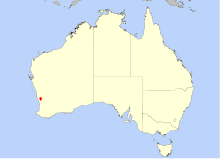Drosera walyunga
| Drosera walyunga | ||||||||||||
|---|---|---|---|---|---|---|---|---|---|---|---|---|
| Systematics | ||||||||||||
|
||||||||||||
| Scientific name | ||||||||||||
| Drosera walyunga | ||||||||||||
| NGMarchant & Lowrie |
Drosera walyunga is a carnivorous plant of the genus sundew ( Drosera ). It belongs to the group of so-called dwarf sundews and is native to southwestern Australia.
description
Drosera walyunga is a perennial herbaceous plant . This forms a flat, compact, rosette-shaped bud made of leaves with a diameter of about 2 cm. The stem axis is short and covered with few or no withered leaves from the preseason.
The bud of the stipules is ovate, smooth, 5 mm long and 4 mm in diameter at the base. The stipules themselves are 4 mm long, 2 mm wide, 1 mm wide at the base and trilobed. The middle lobe is divided into 2 segments and the edges are noticeably sawn . The lateral lobes are entire , sometimes divided for a short distance at the tip. The inner and outer edges are sawn .
The leaf blades are elliptical , 3.2 mm long and 2.5 mm wide. The longer tentacle glands are on the edge, the shorter ones on the inside. There are some glands on the underside. The leaf stalks are 5 mm long, 0.5 mm long at the base, widen to 0.9 mm in the middle and taper to 0.8 mm at the leaf blade. Sometimes they are lanceolate with a few glands on the underside near the leaf blade, otherwise hairless.
Flowering time is October to November. The one, rarely two flower stems are up to 9 cm long and completely densely covered with glands. The inflorescence is a coil of 12 or more flowers on approximately 2.5 mm long flower stalks. The obovate sepals are 3 mm long and 1.8 mm wide. The margins are whole , the tips serrated irregularly . The surface is covered with a few glands, the base is densely glandular. The petals are white, pale pink or dark pink. They are clearly cello-shaped, 8 to 10 mm long, 6 mm wide at the tip, taper to 3.3 mm in the middle, widen to 4.5 mm at the base and form a distinct, wedge-shaped finger there. The tips are slightly notched and the margins are whole .
The 5 stamens are 2.5 mm long. The stamens are greenish white, the anthers are white with red spots and the pollen are orange. The pale green ovary is top-shaped, 0.9 mm long and 1.1 mm in diameter. The 3, sometimes 4 white, styluses are 0.15 mm in diameter at the base and widen to 0.2 mm. They are 0.5 mm long at the top and 1.2 mm at the bottom of the scar. The scars are whip-like and taper evenly from the enlarged point of the stylus-scar segment towards the tip. They are arranged in such a way that there is an upward-facing "bull horn" arrangement. The scars are white with a pink shade. The entire stylus-scar segment is 3.5 mm long.
The formation of brood scales is typical of dwarf sundews.The broad, egg-shaped, 1 mm thick brood scales are formed in large numbers from late November to early December and are approx. 1.5 mm long and 1 mm wide.
The number of chromosomes is 2n = 16.
Distribution, habitat and status
Drosera walyunga only occurs in a small area in the extreme southwest of Australia. The plant thrives there on sandy white clay with a thin layer of laterite gravel in open areas in light heathland. This species grows in and around winter damp springs and seepage within the Walyunga National Park. Although the species is abundant, the only known population is in Walyunga National Park .
Systematics
The name "walyunga" refers to the place where the plant was found, the Walyunga National Park.
literature
- Allen Lowrie: Carnivorous Plants of Australia. Volume 2. University of Western Australia Press, Nedlands 1989, ISBN 0-85564-300-5 , p. 174.
Individual evidence
- ^ Drosera walyunga at Tropicos.org. In: IPCN Chromosome Reports . Missouri Botanical Garden, St. Louis
